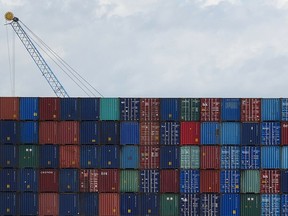Backlog created by the strike could last weeks after operations resume, with service delays potentially extending well into 2025
Article content
We are now on day six of the nationwide mail strike, after year-long negotiations between Canada Post and the Canadian Union of Postal Workers (CUPW) failed last week and 55,000 postal workers hit the picket lines — just ahead of Black Friday and the busy holiday season. Here’s the latest on the ongoing talks and the strike’s impact on Canada Post customers.
How did we get here?
Advertisement 2
Article content
The dispute centres on wages, pensions, and medical leave, as well as Canada Post’s plan to offer seven-day parcel delivery, which the CUPW opposes on the grounds that it opens the door to contract workers. On wages, the two sides seem to be far apart. Management has proposed an 11.5 per cent wage increase over four years, while the union is asking for 24 per cent cumulative over the same time period.
The union has accused the corporation of failing to negotiate in good faith, stating that “Canada Post left us no choice when it threatened to change our working conditions and leave our members exposed to layoffs.” Jon Hamilton, Canada Post’s vice-president of strategic communications and stakeholder engagement, explained, “We need to make changes to our delivery model to bring some flexibility in so we can be more competitive and grow our parcel business.”
Jan Simpson, CUPW’s national president, acknowledged that Canada Post has had the ability to offer seven-day delivery since 2018 and says the service was previously in operation in Montreal. However, she criticized the corporation’s cost-cutting measures, which include replacing full-time workers with part-time staff earning lower wages and benefits. “For us, we try to create and keep good, full-time jobs,” she said, emphasizing the union’s goal of maintaining quality employment opportunities for future generations.
Advertisement 3
Article content
Hamilton says the mediation efforts continue, stating, “We’re in day three with the special mediator. We’ve had the assistance of mediators since October, but this is a different step, with a special mediator that’s working with the parties.”
How is the work stoppage affecting business customers?
The strike has thrown small businesses into disarray, since many rely on Canada Post for shipping goods and sending and receiving invoices and payments. According to the Canadian Federation of Independent Business (CFIB), 80 per cent of small businesses depend on the postal service for some aspect of their operations.
The strike comes at a time when many small retailers are already feeling the pinch, along with the cumulative impact of the recent port disputes. “It’s been a tough couple of years for small businesses,” said Corinne Pohlmann, executive vice-president of advocacy at CFIB. “Consumer demand seems lower than expected because people are unsure about delivery timelines and some are staying away from shopping altogether, fearing delays. Members are worried about receiving their inventory in time for the Christmas season. It’s just the next big obstacle they have to deal with.”
Article content
Advertisement 4
Article content
Larger businesses, meanwhile, have also scrambled to adapt. Rogers Communications Inc., for instance, sent an email to clients ahead of the strike warning of potential delays in receiving paper bills. “Not to worry — we’ve got you covered,” the message reassured, encouraging customers to switch to online billing through the MyRogers portal. However, like some banks and credit card companies, Rogers reminded customers that bill payments would remain due on time, regardless of postal delays.
How are small businesses adapting to the disruption?
Mary Muscat, owner of Sparta Country Candles and Anything Used, located southeast of London, Ontario, described how the strike is affecting her business. “We’re a one-store operation, in a small village of 200 people. We’ve been here for 32 years,” said Muscat. “Our candles ship out daily across the country, and sometimes to the U.S. Shipping out of province is now much more expensive. With Canada Post, we used to have more affordable options, but we can’t rely on that now.”
For many small businesses, the strike is both costly and inconvenient. “We have to take our parcels into town, which is 20 minutes away, to the one small UPS outlet,” Muscat said. “There are a lot of places we ship to in Ontario, and if the order is $45 or more, it’s free shipping. Our courier company can’t deliver cheaper than Canada Post, so we’ve lost that edge.”
Advertisement 5
Article content
Muscat says 50 per cent of her business relies on the holiday rush. Another concern is payment processing. “We’re dependent on getting payments in 30 days by cheque, and that’s not going to happen anymore. We can try e-transfer, but not all companies are set up to accommodate that.”
How is the work stoppage affecting residential customers?
The timing of the strike couldn’t be worse for consumers. With Black Friday sales underway, holiday gift deliveries and seasonal greetings are hanging in the balance. NerdWallet Canada’s spokesperson and financial expert Shannon Terrell says that, for consumers, adaptation will be essential. “For everyday Canadians caught in this delivery debacle, adaptation will be key — whether it be local in-person shopping, click-and-collect options from major retailers, or digital gift-giving alternatives.”
According to NerdWallet Canada’s recent holiday survey, 26 per cent of shoppers are planning to give fewer gifts this year, a strategy that would sidestep potential delivery disruptions altogether.
How will a protracted work stoppage affect Canada Post?
Advertisement 6
Article content
Canada Post, which already reported a loss of $490 million in the first half of 2024, continues to struggle financially, with more than $3 billion in cumulative losses since 2018. Compounding its woes, Teamsters Canada, whose members work for Purolator, announced they won’t handle packages originating from Canada Post, further straining operations and pushing businesses to seek more expensive alternatives.
The strike underscores broader challenges facing Canada Post in an increasingly digital economy. Declining mail volumes and stiff competition from private couriers have left the Crown corporation struggling to stay relevant and financially viable. Recent innovations such as seven-day parcel delivery haven’t been enough to stem financial losses. Unlike private couriers, Canada Post continues to carry the costly obligation of delivering to remote areas, making it indispensable to rural communities but financially vulnerable.
Hamilton pointed out the severity of the situation: “We’re trying to grow our parcel business, we’re reducing our costs, but now, even with any plans we had, the union has shut down the postal system at the busiest time, when Canadians are counting on us.”
Advertisement 7
Article content
Adding to this, he noted the long-term consequences, stating, “The hit to our reputation, to the trust we have with our customers, has taken a massive hit. We’re taking a step in the wrong direction right now…we’re going to have to be focused on building back the trust from Canadians.”
What comes next?
While Labour Minister Steven MacKinnon appointed mediators to help the parties reach an agreement, he stopped short of confirming whether the government might introduce back-to-work legislation. In 2018, Ottawa ended a 36-day long rotating postal strike by mandating workers back to their jobs — a decision heavily criticized by labour groups.
“We’ve seen workers across the country going on strike this past year. It’s ringing the alarm that employers are sitting back and waiting for the government to intervene, and they are not bargaining in good faith,” says Simpson. “We know that the best contracts are those that are negotiated at the table, with experts from both sides trying to resolve issues. When you have arbitration, issues are not resolved and they’re brought to next rounds of bargaining.”
Advertisement 8
Article content
Canada Post has warned that the backlog created by the strike could last weeks after operations resume, with service delays potentially extending well into 2025. As labour tensions escalate and financial pressures mount, the strike could be a defining moment for Canada Post, raising questions about its long-term viability and the government’s role in ensuring its future.
Still, Simpson criticized Canada Post’s response to the strike, particularly its decision to issue a lockout, which she said unfairly impacted workers. “They’ve taken away our wages, benefits, and pay for those with vacations booked,” she explained. Vulnerable employees, such as those on short-term disability, have also seen their payments halted. Despite these tensions, Simpson emphasized the union’s commitment to their work, including delivering socioeconomic cheques during the strike.
Recommended from Editorial
-

Will Canada Post deliver? A look inside the labour dispute
-

Labour minister moves to end port lockouts in Montreal, B.C.
Canada Post and CUPW workers have agreed to continue delivering benefit cheques from eligible and participating government organizations during the disruption, so Canadians who receive their Canada Child Benefit or Old Age Security or other pension benefit by mail can expect it to be delivered as normal.
• Email: shcampbell@postmedia.com
Bookmark our website and support our journalism: Don’t miss the business news you need to know — add financialpost.com to your bookmarks and sign up for our newsletters here.
Article content
Will striking Canada Post employees be forced back to work?
2024-11-20 19:01:42






